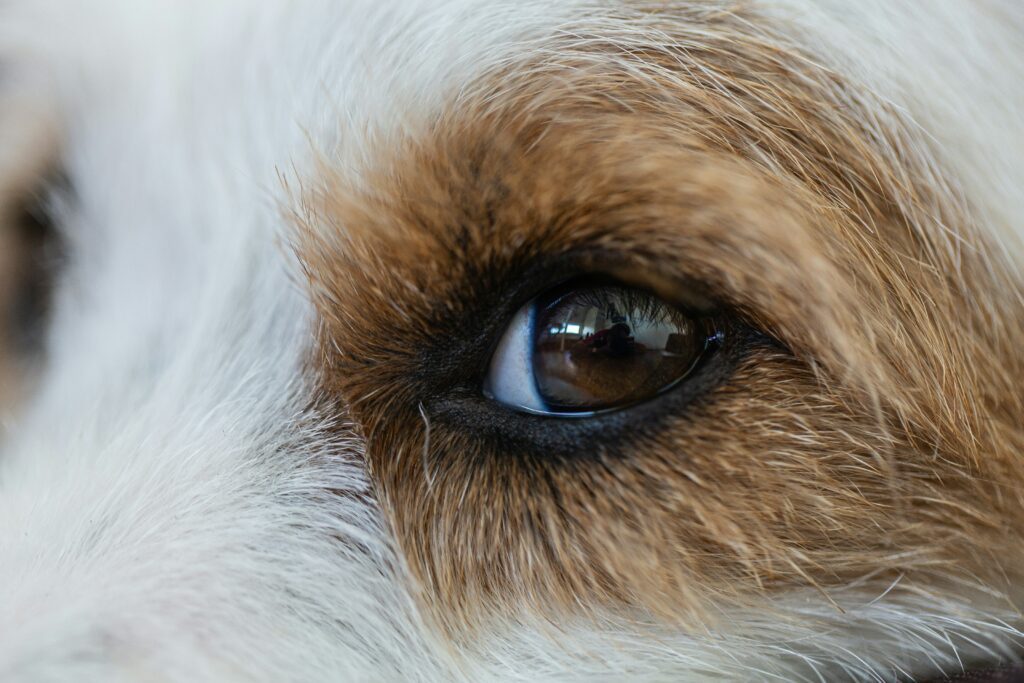Dogs are not completely colorblind, but their color vision is limited compared to that of humans. While humans have three types of color receptors (cones) in their eyes that detect different wavelengths of light corresponding to blue, green, and red, dogs have only two types of cones. This means that dogs are dichromatic, and their color vision is primarily limited to shades of blue and yellow.
Dogs are less sensitive to red and green wavelengths, and they see the world in a range of blue and yellow hues. It’s a common misconception that dogs see the world in black and white; however, they do perceive a spectrum of colors, just not as rich or diverse as the human spectrum.
Despite their limited color vision, dogs have excellent motion detection and night vision, thanks to a higher number of rod cells in their retinas. They rely more on their keen sense of smell and hearing than on their vision for navigating the world.
While dogs are not completely colorblind, their color vision is different from that of humans, and they primarily see the world in shades of blue and yellow.
Here are several misconceptions that exist about a dog’s eyesight. Here are some common ones:
Dogs see the world in black and white: This is a widespread misconception. While dogs have limited color vision compared to humans, they are not completely colorblind. Dogs can see shades of blue and yellow.
Dogs have poor vision: While dogs may not see as much detail as humans, they have remarkable vision, especially in low-light conditions. Their eyes are adapted for detecting motion and seeing well in dim light.
Dogs rely on vision more than other senses: Dogs heavily rely on their sense of smell and hearing. While their vision is essential, they use their other senses to gather information about the world around them.
Dogs can’t see well in the dark: Contrary to this belief, dogs have better night vision than humans. Their eyes contain more rod cells, which are sensitive to low light, allowing them to see well in low-light conditions.
Dogs don’t get cataracts: Dogs can develop cataracts, a clouding of the lens in the eye that can affect vision. This condition is not exclusive to humans.
Dogs can’t see TV or screens: Dogs can see television and other screens, but their perception may differ from humans. Some dogs may be more interested in moving images, while others may not pay much attention.
Dogs see the world exactly as humans do: Dogs’ visual perception is different from humans. They may notice different details, and their ability to perceive certain colors is limited. Understanding these differences is crucial for effective communication and training.
It’s important for dog owners and enthusiasts to be aware of these misconceptions to better understand and care for their canine companions. If there are concerns about a dog’s eyesight or vision-related behaviors, consulting with a veterinarian is recommended.

How did people come into the assumption that dogs are colorblind?
The belief that dogs are colorblind is a common misconception that likely stems from early scientific studies and misinterpretations. While it is true that dogs have a different type of color vision compared to humans, they are not completely colorblind. The origins of the idea that dogs see the world in black and white can be traced back to the 1930s when a scientist named Will Judy published a book titled “Training the Dog.” In this book, he asserted that dogs were colorblind and could only see shades of gray. This idea gained traction and became widely accepted.
However, subsequent research has shown that dogs do have some color vision, although it is limited compared to humans. Dogs are dichromatic, meaning they have two types of color receptors (cones) in their eyes, sensitive to blue and yellow wavelengths. They lack the third cone for red and green wavelengths, which humans possess. As a result, dogs perceive a more limited spectrum of colors.
Despite the advancements in our understanding of canine vision, the notion that dogs are colorblind has persisted in popular culture. It’s a simplified explanation that has been passed down over the years and may be easier for people to remember, even if it doesn’t accurately reflect the complexity of a dog’s vision.
In summary, while dogs don’t see the full spectrum of colors as humans do, they are not completely colorblind. They can perceive shades of blue and yellow, and their vision is adapted to suit their needs for hunting, scavenging, and navigating the world.
If dogs aren’t colorblind? What do dogs really see?
Dogs see the world differently than humans due to differences in their vision anatomy. As we mentioned earlier, dogs are not completely colorblind, however, their color vision is limited compared to us humans. Here are some key points about what dogs see:
Limited Color Vision: Dogs are dichromatic, meaning they have two types of color receptors (cones) in their eyes. They are most sensitive to blue and yellow wavelengths, but their ability to perceive red and green is reduced. As a result, they see a more muted spectrum of colors.
Blue and Yellow Dominance: The world appears in shades of blue and yellow to dogs. Reds and greens may appear similar, and some colors may look more washed out.
Motion Detection: Dogs have a higher number of rod cells in their retinas, making them well-adapted to low-light conditions. This adaptation allows them to detect motion effectively, which is an essential skill for hunting and survival.
Blurrier Vision: While dogs have good motion detection and night vision, their overall visual acuity is lower than that of humans. They see less detail, and objects at a distance may appear blurrier.
Peripheral Vision: Dogs have a wider field of view than humans, reaching approximately 240 degrees compared to humans’ 180 degrees. This wide peripheral vision allows them to be more aware of their surroundings.
Low Sensitivity to Detail: Dogs have fewer cone cells responsible for detailed vision. As a result, they may not see fine details or read as much visual information as humans.
It’s important to note that a dog’s visual perception is adapted to its natural behaviors, such as hunting and tracking. While their color vision may be limited, dogs compensate with heightened motion detection and superior night vision. Understanding these differences can help in training, communication, and providing appropriate care for our canine companions.
















